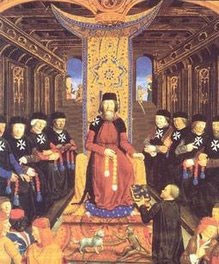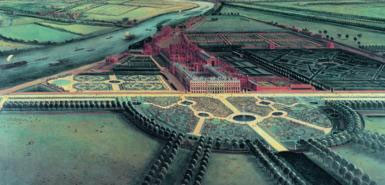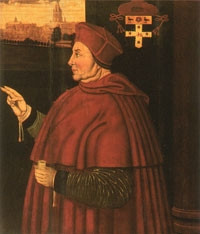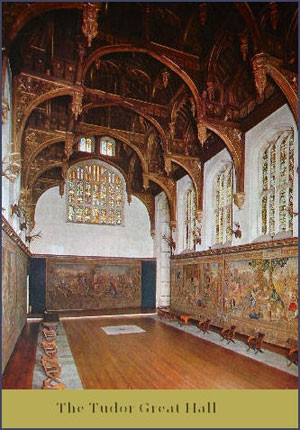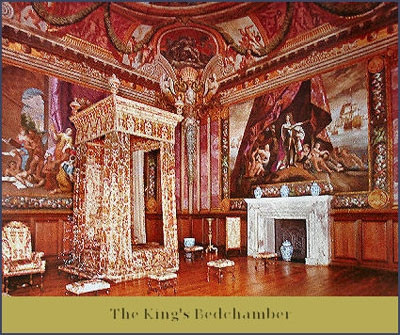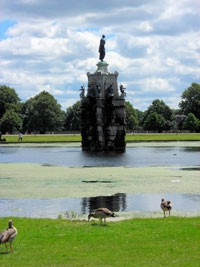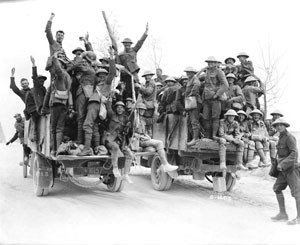Local History
Hampton Court lies within a loop of the Thames which has been settled for 4,000 years. A Bronze Age barrow was excavated in the park and there is evidence of an early farming community and traces of the largest and most complete medieval field system in Middlesex. Before it became a park, the area to the west belonged to the village of Hampton and was called Eastfield because it was cultivated land east of the village.
The Mute Swan at Hampton Court boasts a spectacular view over the Thames and Hampton Court Palace, with its centuries of history, which is literally a stone's throw from our front door. Our pub looks over the original Tudor part of the palace, which is also the main visitor entrance.
Hampton Court Palace
Inevitably, any history associated with the village of Hampton is centered on Hampton Court Palace, built by Cardinal Wolsey between 1515 and 1521.
The palace was built on the site of a former medieval manor house, the preceptory of the Knights Hospitallers of St John of Jerusalem. The Knights Hospitallers was an organization that began as an Amalfitan hospital in Italy to provide care for pilgrims to the Holy Land. After the conquest of Jerusalem during the First Crusade it received Papal approval and became a religious military order under its own charter charged with the care and defense of the Holy Land.
The manor house of these knights stood in the village of Hampton (which means 'The farm on the bend of the river'), but for Wolsey to realise his plans for the palace, the village effectively had to be moved, and two new Hamptons were created - Hampton-on-Thames upstream, and Hampton Wick ("Village") downstream.
The two villages were separated by the royal gift from Henry VIII to Wolsey of 1,099 acres of hunting land - now Bushy Park and Hampton Court Park.
This created administrative friction between the two Hamptons, which were administered as one entity until the Wick Hampton declared itself independent in 1831. Hampton-on-Thames expanded northwards in the early 19th century to create the settlement of New Hampton, which become its own parish in 1863. Shortly after, the inhabitants forced a name change to Hampton Hill, even though, strangely enough, there is no hill there.
At the end of the contract for Wolsey's purchase of the original manor house is a curious list of the goods of the Knights Hospitaller, which were left in the house when he took possession of the building. They were extremely meagre: even in the chapel the chalice was made of silver rather than gold. An item of twenty-two beds gives an idea of the size of the house. In the hall were some benches, two tables, and a cupboard. There were also some chests, and two bells in the 'toure,' one of which, the sole remaining relic of the order of the Knights Hospitallers of St John of Jerusalem, still rings for service in the chapel to this day.
Cardinal Wolsey, the Lord Chancellor of England, was an extremely charismatic man. Sebastian Giustinian, the Venetian ambassador who frequently visited Wolsey at Hampton Court, writing to his Signory in 1519, gives the following description of the cardinal: 'He is but forty-six years old, very handsome, learned, extremely eloquent, of vast ability, and indefatigable. He alone transacts the same business as that which occupies all the magistracies, offices and councils of Venice, both civil and criminal, and all state affairs likewise are managed by him, let their nature be what it may. He is pensive and has the reputation of being extremely just. He favours the people exceedingly, and especially the poor, hearing their suits and seeking to dispatch them instantly. He is in very great repute, seven times more so than if he were Pope. He is the person who rules both the king and the entire kingdom. He is in fact ipse rex, and no one in this realm dare attempt aught in opposition to his interests.'

Henry, obviously, wasn't impressed by the idea that there might be an 'ipse rex', and by 1526, Wolsey's star was on the wane, and Wolsey gave Hampton Court to Henry VIII in an attempt to save his rapidly crumbling political career. The gamble failed however, and Wolsey, a treasonable entity in Henry's eyes since he failed to clear the king's path to divorce Catherine of Aragon and marry Anne Boleyn, died on his way to a treason trial in 1530. Corporate poltics...
Henry, nothing if not selfish, did love the palace. He was famously prolific in palace building, and in just ten years he spent more than £62,000 rebuilding and extending Hampton Court, a sum that would be worth approximately £18 million today, with the result that the Palace was one of the most impressive in Europe.
It included expansive state apartments, kitchens covering 36,000 square feet (to put that into context, a modern kitchen that can look after 350 diners a day might genourousy occupy 1,000 square feet), a great hall and a sophisticated toilet building. The two-storey toilet house, the Great House of Ease, was built in 1534. It was constantly fed by running water from the Thames. There were 13 seats on each floor and it was a definite advantage to be on the upper floor.Would you not agree that a "Great House of Ease" is the most eloquent way of discribing a loo...ever ?
It began a long love affair between monarchy and the building that lasted down to Victoria. She opened Hampton Court Palace to the public and the Government took over administration in the same year, 1851. Bushy Park and Hampton Court Park were enclosed as hunting grounds by Henry VIII in 1538 but upon his death in 1547 the fences were pulled down and the public have had access ever since.
Bushy Park
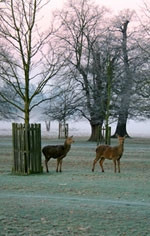
The vast expanse of Bushy Park (1,099 acres) makes it the second largest Royal park in London. Lying to the north of Hampton Court Palace, the history of Bushy Park is inextricably linked to the Palace. Most people in Hampton live within walking or cycling distance of the park and will quickly volunteer how much they enjoy the park for its wide open spaces, for a sight of the 325 deer which roam in the grounds or for the beautiful, 60-acre Waterhouse Woodland Gardens.
The ornamental waterworks in Bushy Park and at Hampton Court Palace were initiated by Charles 1. He wanted to show how powerful he was by building fountains, lakes and ponds to rival those belonging to other European monarchs. However, to achieve his plan he needed a flow of water to work the fountains and fill the lakes. Water from the River Colne was directed to Hampton Court and the park. A canal, more than 12 miles long, was dug by hand and was completed in 9 months at a cost of £4,000.
During World War 1 large numbers of Canadian troops were stationed in the park. One of the large houses in the park, Upper Lodge, (previously a hunting lodge rebuilt around 1710 by the first Earl of Halifax) was used as the King's Canadian Hospital.
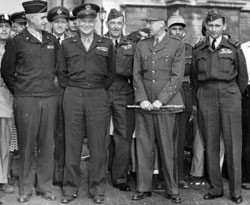
In World War Two, part of Bushy Park became the site of a large US base called Camp Griffiss. In February and March 1944, General Eisenhower moved SHAEF (Supreme Headquarters Allied Expeditionary Forces) to Bushy Park from where the initial planning stages of Operation Overlord, the Normandy invasion, took place.
Near the Teddington end of the park, not far from Chestnut Avenue, a USAAF Memorial Plaque commemorates these events. Only when the war was over did local people learn the vital role Bushy Park had played.
(Thanks to www.ourhampton.org.uk)
Hampton Court Funfair
The Annual Easter Bank Holiday Funfairs on Hampton Court Green have run for 150 years, unbroken even by two world wars. They are a fundamental part of the history of the area, and of London itself.
In 1838, Queen Victoria, having decided to no longer use Hampton Court Palace as a Royal Residence, opened the Palace State Apartments to the public. The decision was popular with Londoners who flocked to the area in vast numbers, but also controversial, as the Palace was one of the few places open to the public on Sundays, leading to opposition from traditionalists and some religious groups. With the crowds came a group of enterprising showmen who set up games stalls such as Coconut Shies, Tests of Strength and Fortune Tellers along the River side near to the Palace, plying their trade with visitors.
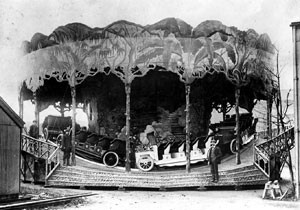
At some time between 1838 and 1854 this ad hoc collection of stalls was changed into a formal and large bank holiday funfair, and according to the oral history of the Showmen's Guild this followed the brave actions of a Showman named Stephens, who rescued a small boy from drowning in the River by Hampton Court Bridge. According to this story, Billy Stephens was crossing the bridge when he saw a young boy struggling in the Thames. He dived in and saved his life, then discovered that the child was the son of a senior Lieutenant from the Palace. He was asked what reward he would like for his bravery, and he replied that he would like to be granted the right to stage a large funfair on the Green every Bank Holiday weekend, and this was agreed. There are slight amendments to this story in that one version states that he had paid the child sixpence to jump in the water, and another that he actually pushed the boy in!
At the turn of the century, Hampton Court Green became a major tram terminus and this, together with the improvements to the railway system meant that all Londoners could, and did, visit the Green for their fairs. Even the use of part of the Green during the First World War did not prevent the fair from being held, as the Government recognised the importance of this for maintaining morale.
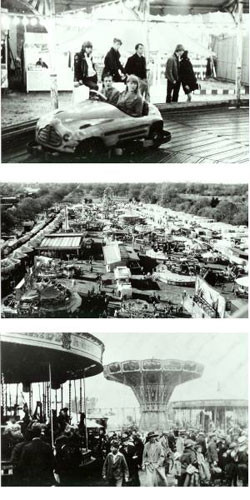
It is always difficult to separate myth from fact in funfair history, but it is claimed that the first ever set of Dodgem Cars were shown at Hampton Court, and also that World Champion Boxers would visit and take part in boxing displays for the entertainment of visitors.
During the Second World War, the Government worked with the Showmen's Guild to ensure that there was quality entertainment for Londoners during the Blitz, to raise morale and to reduce the pressure on transport to the seaside. These "Stay at Home Holiday" fairs took place in many areas of London, and Hampton Court Fair was maintained as part of this programme.
Hampton Court Funfair has provided 150 years of recorded history on the Green, and still provides superb family entertainment at the ever popular Easter weekend. There are always the traditional Carousel and Big Wheel, plus games stalls, family favourites such as the Dodgem Cars and Twister rides, and modern virtual reality opportunities.
(Thanks to http://www.hamptoncourtfunfair.com)

